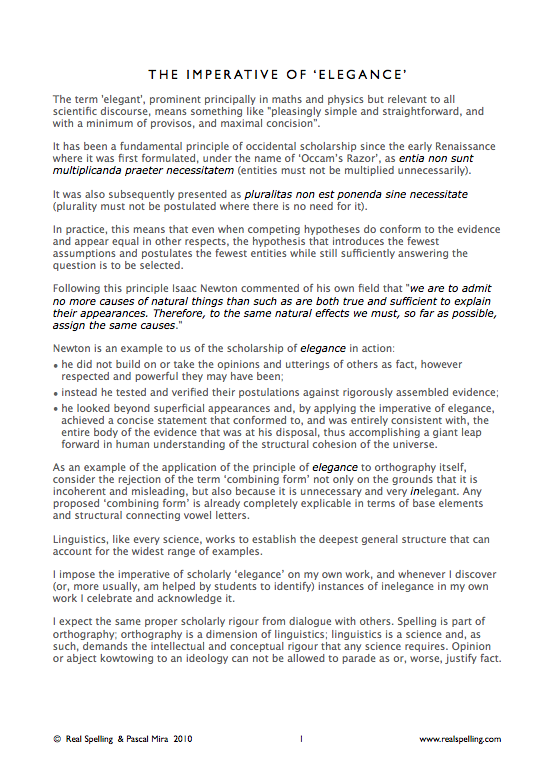Seeking the Elegant Solution: Critical Thinking in the Classroom
Copyright Susan and Peter Bowers 2008

Using Scientific Principles to Resolve Questions in the Classroom
It is common in structured word inquiry classes to arrive at competing solutions to a question. Therefore, if teachers and students are going to act as scientists, they need reliable criteria for determining whether one answer is best.
Fortunately, teachers can draw on well established scientific principles to resolve such questions, and use such events as an opportunity to establish and apply those scientific principles with young children. I argue that this instruction targets the development of critical thinking skills and attitudes as much as it does the development of literacy skills.
Here is one simple example from my own first months of working with Real Spelling as a Grade 4 teacher. I remember one day analysing the structure of a word like <biked> with my Grade 4 students. The question came up whether this word used an <-ed> suffix or a <-d> suffix. Either word sum seemed to create the same correct spelling:
bike + d → biked
bike/ + ed → biked
In considering these two possibilities, we decided that it was unnecessarily complicated to suggest that there are <-ed> and <-d> suffixes and that we use one when fixing it to a base or stem ending in a single, silent <e> and another when adding to other bases or stems. It seemed more logical to simply treat <-ed> suffixes like any vowel suffix which replaces single, silent <e>s. I later discovered that my desire to avoid unnecessarily complicated solutions is a well established principle of science described by Occam’s Razor and the principle of “elegance” that Melvyn describes in the article I have attached below. (Note: there is in fact a no-longer-productive suffix <-d> that does occur, but not for the reason of avoiding dropping a single, silent <e>. You can learn about such ‘dead suffixes’ in Kit 4G in the Real Spelling Tool Box 2.
It may surprise you that principles like these can be cultivated and applied in young classes, but as shown with the example above, a simple word like <biked> offers the chance to engage with this kind of thinking. See this video clip to see another example of elementary students working through exactly this kind of work while investigating the structure and meaning of the word <ruptured>.
These principles are also essential for helping students and teachers gain confidence to challenge statements by authoritative but fallible resources. The example I often use for this is an investigation the Oxford English Dictionary and the <*-tion> “suffix”. Here is what my Oxford says:
If we accept what Oxford says here, we would have to accept these word sums for the examples it gives:
*comple + tion → completion and *rela + tion → relation
These word sums are clearly incoherent compared to word sums which reveal the underlying stems of these words:
complete/ + ion → completion and relate/ + ion → relation
This simple analysis with word sums provides incontrovertible evidence that, in this case, the examples provided by the Oxford English Dictionary are “less elegant” that what we can present ourselves. Following scientific principles allows us to create an culture of learning in our classrooms in which children are encouraged to question even the most authoritative sources if they can come up with a more elegant description of how the world works. We learn to not believe things based on who said them, but by whether the statements hold up to to the evidence. Most curricula I see emphasized the importance of the ability of future generations to be able to filter and critically analyse information in the 21st century. When structured word inquiry is used to effectively contradict the Oxford English Dictionary, it shows that this instruction can be an extremely rich context for the kind of critical thinking teachers are charged with facilitating.
Click the image below to download a pdf of the article titled: The Imperative of ‘Elegance’.
That document was constructed for participants at my workshop for the Orton-Gillingham based “Valley of Chicago Learning Center” April 17 - 18. Melvyn offered this document as a follow-up for a fascinating discussion that came up about the spelling of the word <caught>. I’ve included this document here as a detailed articulation of the scientific principles that should guide structured word inquiry.
In this document, Melvyn refers to the terms/concepts “connecting vowel letters’ and ‘combining forms’. To interrogate the description of ‘elegance’ presented here, you will need to know something more about these terms. I’ve included links to tutorial clips on this concepts from the Real Spelling Gallery.
See the Connecting Vowel Letters Tutorial Clip here.
See the “Combining Form” Tutorial Clip here.
-tion
suffix
forming nouns of action, condition, etc., such as completion, relation.

